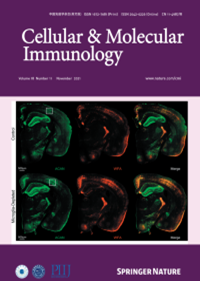人肝脏免疫学:从体外模型到新见解。
IF 19.8
1区 医学
Q1 IMMUNOLOGY
引用次数: 0
摘要
肝脏承载多种免疫细胞,同时在稳态条件下创造耐受性环境。然而,随着时间的推移,大多数慢性肝病会转向炎症。了解和拦截各种免疫细胞和肝组织之间的串扰至关重要,因为它通常是临床前药物开发的限速因素。由于肝脏免疫学在物种间的显著差异,人类模型,如经典共培养或具有免疫室的器官发生启发的肝类器官,对于推进该领域变得至关重要。因此,本综述评估了人类特异性肝免疫串扰模型,并评估了从基本2D培养到微生理系统(mps)和高级多组织类器官的一系列模型。它可以作为实验人员确定合适方法的指南。例如,传统共培养具有稳健性、还原性和模块化,但空间保真度和细胞异质性有限。相比之下,受哺乳动物个体发育启发的多组织类器官是由多能干细胞产生的,并整合了多个组织龛构成细胞,其中包括库普弗样细胞。总之,这篇综述讨论了人类肝脏免疫学建模的进展,并强调了局限性和许多未开发的机会。这些包括体外自身免疫模型和更复杂的骨髓炎症反应的潜力,包括胚胎组织和骨髓的贡献。此外,未来的体外模型可能包括难以培养的群体,如中性粒细胞。本文章由计算机程序翻译,如有差异,请以英文原文为准。

Human liver immunology: from in vitro models to new insights
The liver hosts a variety of immune cells while creating a tolerogenic environment under homeostatic conditions. However, most chronic liver diseases shift toward inflammation over time. Understanding and intercepting the crosstalk between various immune cells and liver tissue is crucial, as it is often the rate-limiting factor in preclinical drug development. Owing to significant interspecies differences in liver immunology, human models, such as classical cocultures or organogenesis-inspired liver organoids with immune compartments, are becoming essential for advancing the field. Therefore, this review evaluates human-specific models of hepatic-immune crosstalk and assesses a range of models from basic 2D cultures to microphysiological systems (MPSs) and advanced multitissue organoids. It serves as a guide for experimentalists to identify suitable approaches. For example, traditional cocultures offer robustness, reductionist approaches, and modularity but have limited spatial fidelity and cell heterogeneity. In contrast, multitissue organoids inspired by mammalian ontogeny are created from pluripotent stem cells and integrate multiple tissue niche-constituting cells, which include Kupffer-like cells. In conclusion, this review discusses progress in human liver immunology modeling and highlights limitations and numerous untapped opportunities. These include the potential to model in vitro autoimmunity and more complex myeloid inflammatory responses, incorporating contributions from embryonic tissue and bone marrow. Additionally, future in vitro models may include hard-to-culture populations such as neutrophils.
求助全文
通过发布文献求助,成功后即可免费获取论文全文。
去求助
来源期刊
CiteScore
31.20
自引率
1.20%
发文量
903
审稿时长
1 months
期刊介绍:
Cellular & Molecular Immunology, a monthly journal from the Chinese Society of Immunology and the University of Science and Technology of China, serves as a comprehensive platform covering both basic immunology research and clinical applications. The journal publishes a variety of article types, including Articles, Review Articles, Mini Reviews, and Short Communications, focusing on diverse aspects of cellular and molecular immunology.

 求助内容:
求助内容: 应助结果提醒方式:
应助结果提醒方式:


